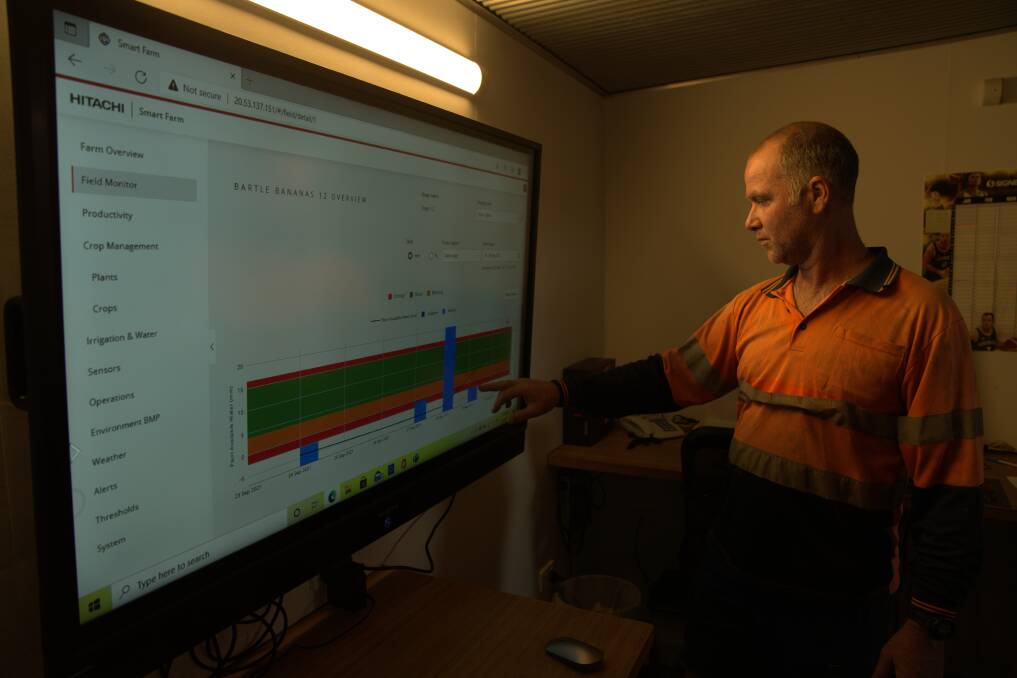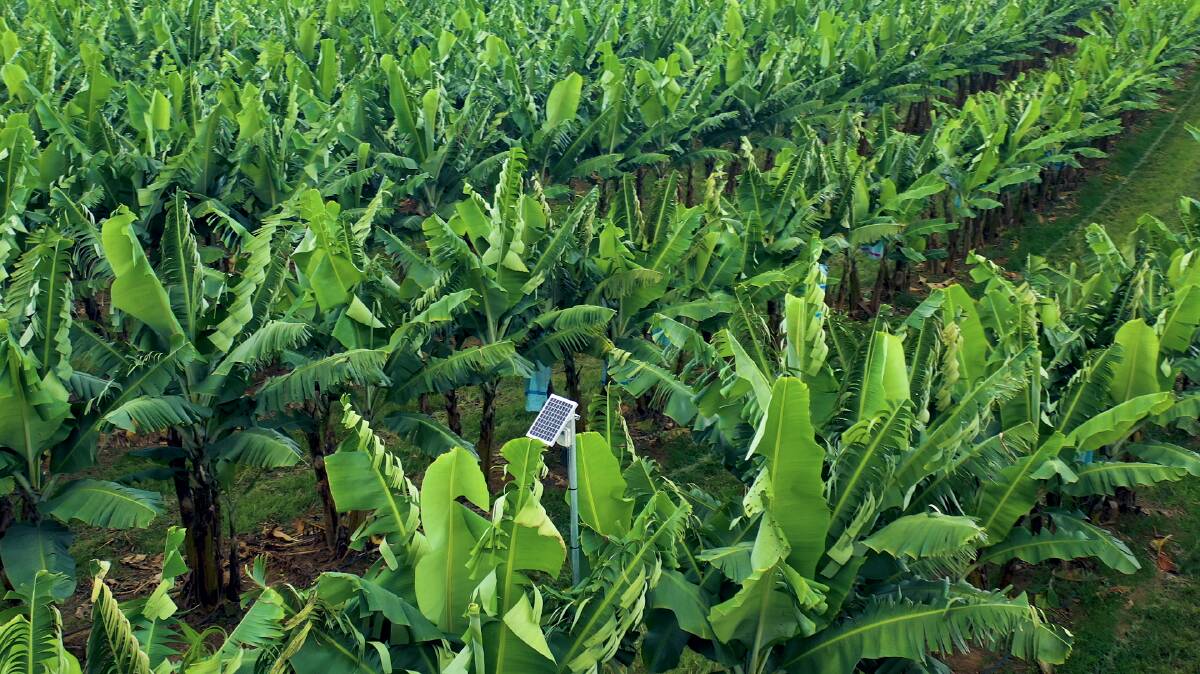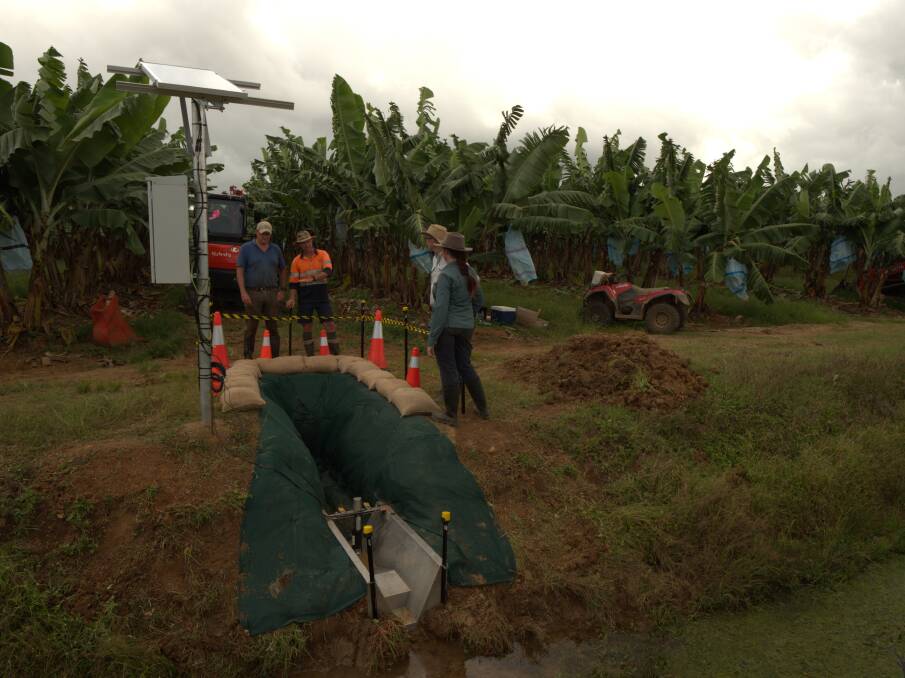Data helps grow better bananas

This is branded content for Department of Agriculture and Fisheries.
GAVIN Devaney has a crystal ball, of sorts, but there's no hocus pocus involved.
The forward thinking grower has embraced cutting edge technology on his family property, Bartle Frere Bananas, in order to reduce the environmental impact of his farming practices while also lifting consumer confidence in his product.
The 101 hectare (250 acre) farm, located at Boogan, south of Innisfail, has hosted the Data Driven Sustainable Smart Farming Project - a joint initiative between Applied Horticulture Research and Hitachi Vantara.
Numerous sensors have been installed throughout the farm, plus vehicle trackers and a weather station, all integrated and feeding information back to a single, readable output.
Weather tracking, forecasting, soil moisture sensors and AI modelling enable Mr Devaney to determine how much, when, and precisely where controlled irrigation is required.
This has resulted in healthier plants and reduced water usage, since irrigation pumps are only run when necessary.
Monitoring run-off
PART of the technology includes solar-powered inline nitrate sensors to help ensure fertilisers are not overused. Previous research by agronomists at the Department of Agriculture and Fisheries (DAF) has shown that over application of irrigation water can accelerate nutrient loss through deep drainage.
The nitrate sensors continuously monitor and report the nitrate levels present in the leachate flowing through the farm's 2.5 kilometres of underground drainage pipes.

This data helps Mr Devaney ensure the bananas are getting enough fertiliser to grow properly, but not so much that it leads to waste in deep drainage and run-off.
To maximise irrigation efficiency, there are also soil moisture sensors at five different depths throughout the root zone of the banana plants.
The magic box
THE "brains" of the operation is the digital twin control tower.
"That control tower is basically an interface that brings all the sensors across the farm into one program and then they run a group of algorithms to be able to give you a recommendation," Mr Devaney said.
When it comes to water management, Mr Devaney describes it as a fuel gauge, telling him where levels are currently at, and what needs to happen in order to maintain correct levels of soil moisture, depending on the forecast that is delivered from the weather station.
Mr Devaney said when it came to developing the system, he was adamant it needed to deliver real time data in order to provide the opportunity to affect change, not just report what has happened.

"If we change a process, we are going to change the levels of run-off leaving the farm," he said.
While he hasn't crunched all the numbers on a financial level to calculate exact cost savings for fertiliser and water, there are obvious savings from the approach, such as improved labour efficiency
For instance, with vehicle and task tracking, a worker conducting bell injection (injecting a chemical into the "bell" of the banana plant) will automatically identify where there are bunches in which rows.
This data will then help direct a worker tasked with bagging the bunches at a later date, as they can go directly to where the bunches are and avoid rows without any fruit.
"All of a sudden you've just saved them driving through every row across 20 acres. That is a cost saving," he said.
Pursuing best practice
BARTLE Frere Bananas has been actively seeking ways to improve their environmental performance for many years.
Some years ago Mr Devaney constructed a large scale vegetated drain to reduce nutrients, sediment and pesticides flowing off the farm into waterways.
This was very effective in denitrifying run-off. Water quality testing showed that farm run-off nitrate levels went from 4.75 parts per million (ppm) before planting, to 0.75ppm when the bananas were well-established.
Mr Devaney also participates in the Banana Nutrient Rate Trials project, run by the Department of Agriculture and Fisheries (DAF), which aims to identify optimum rates of fertiliser application to minimise the amount of nutrient reaching the drains in the first place.
The DAF nutrient trials are based at the South Johnstone Research Facility and commercial farms in the Tully, Johnstone and Russell river catchments.
Farm specific
NOT every banana farm is going to install the level of equipment used at Bartle Frere Bananas, and that's quite okay, according to Mr Devaney.
He said it was important not to see the project as the gold standard for all banana farms, because each property has unique circumstances.
"What this system is doing is turning around and saying, well, you don't have sediment run-off because of these practices, you aren't leaching nitrogen due to your practices," Mr Devaney said.

"But if you took the practices I'm doing here and put them on a volcanic rich, red soil of the Palmerston area, you would end up with a different result again and possibly lose all your sediment down into the river.
"You've got to suit the practices to your place and be given a chance to prove those practices."
He also reinforced that it is an industry project, not his own.
Next up
MR Devaney is keen to pursue the possibility of individual fruit tracking, showing full traceability from the plantation down to the carton, to bolster consumer confidence. This can be done through geolocation, something Bartle Frere Bananas is well down the road on.
"Given what happened to the strawberry industry (the 2018 needle tampering incident), which I think was absolutely criminal, I believe that we need this sort of traceability to provide consumer confidence in all fruit and veg," Mr Devaney said.
The banana industry is working with the Queensland Government on several initiatives to reduce the risk of reef water quality impacts. Mr Devaney is a member of the project reference group for the Banana Nutrient Rate Trials project being delivered by the Department of Agriculture and Fisheries (DAF), part of this banana industry initiative.
In November last year, the farm was put on show at the UN Climate Change Conference (COP26) in Glasgow as part of Hitachi's COP26 presentation entitled Technology and Data Are Key to Save the Environment.
- To find out more about the services DAF offers to primary producers on best practice adoption, and events in your area, visit www.qld.gov.au/FarminginReefCatchments or phone 13 25 23.


